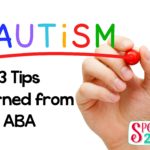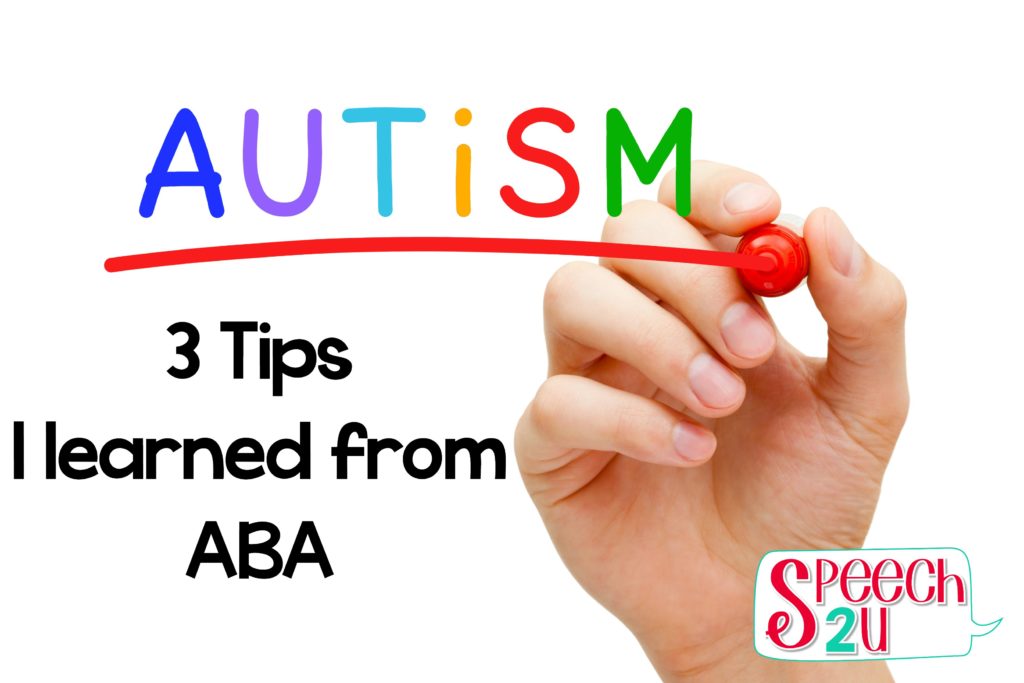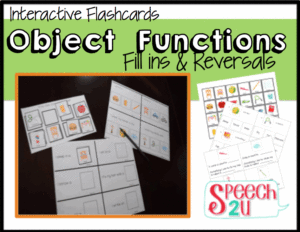April is Autism Awareness Month.
I’ve worked with a lot of individuals with autism. Back in the middle ages, when I was in grad school, I had a one day lecture that talked about autism. When I got into the field, I was unprepared for the clients with whom I was working. I spent a lot of time reading and looking for information on autism and treatment strategies for children with autism. To be honest, I usually start books and I don’t often finish them. I think you get the main idea 5-6 chapters in, but maybe I’m missing the best part of the book.
Today I want to share three things that I think you should absolutely be using in your speech therapy sessions-that I learned from the ABA literature.

I’ll admit: I have not always spoken fondly of ABA or applied behavioral analysis. Mostly because I had met a lot of practitioners who didn’t seem to play fair. It was frustrating to start working with child on the autism spectrum and feel like you were making gains, and then have them begin an intensive program which required the family to stop speech services during their program.
Collaboration, anyone?
What is ABA?
ABA is an acronym which stands for applied behavioral analysis. Speech Language Pathology and ABA share a love for taking data and a common history in BF Skinner and operant conditioning. The field of ABA does a lot of research and uses data to guide their treatment decisions. We could probably take a few lessons from the amount of research that they are doing. For example, I’ve seen some powerful results with 40 hour per week in home intensives. Imagine what we could accomplish with aides completing 40 hours a week of home programming. Would we be considered the new standard of care? It would be an interesting study.
ABA is sometimes used interchangeably to describe early intensive behavior intervention (EIBI) which is a 4o hour per week home program developed by Lovaas. Lovaas’s program using ABA principals. But ABA can be used without completing Lovaas’s program.

The Basics of ABA
Like the title, ABA focuses on analyzing and changing behaviors-including communication behaviors. A therapist may look at a situation to determine:
- What happened (antecedent)
- What did the individual do (behavior)
- What happened next (consequence).
With this information, they can try different interventions to see if these interventions improve the behavior. They can take data over time to see if their interventions were successful. For example, let’s say you have a child who tries to turn off the light every time you go into your therapy room.
What happened: You walked in the therapy room.
What did the individual do? Turned off the therapy light.
What happened next? You yelled Boo and then turned the light back on. Okay that might just be me in therapy. I am a master at reinforcing behaviors that I don’t really want because I am just silly all day long. Now this client is going to do it every time because he really thought that was fun. What can I do?
I can alter my response (consequence) Every time we walk in the room and he turns off the light I can:
- ignore him and not say anything
- tell him why it’s not okay to turn on the light
- take away free time
- give him a sticker each time he doesn’t turn on the light
We can also look at changing the antecedent (what happens right before) I could:
- write a social story to give him more information about turning lights on and off
- try going into a different room
- prompt him to ask before turning on the light
- make sure I have my hand over the light so he can’t turn it off
- Give him objects to hold so that he can’t turn off the light.
Plus: I would want to reinforce the correct behavior. So if I put my hand over the light so he couldn’t turn it off. I could give him a high five and say “I love how you are ready to work!”
One of the great things about gaining knowledge in ABA is that it helps you troubleshoot maladaptive behaviors as well as thinking about breaking down your goals into smaller goals to help the child achieve success.
Gain/Teach Attention
There are several programs that work towards “teaching” attention for children on the autism spectrum using external reward systems and then fading to praise. If you’ve worked with a child who has been through an intensive program, you have probably seen that they have developed a love for picture cards and structured table top activities. So do I. It’s a mutual love we can share together in therapy. I don’t use these programs to teach attention, but I may refer a client who has difficulty engaging at all with me. I need them to attend a little bit so we can make progress.
When you are working with a child on the autism spectrum (or really any child) make sure that you have their attention prior to presenting a direction or request. It’s important to teach and share this with parents, teachers, and para professionals. A lot of children who are on the autism spectrum have processing delays and difficulty filtering information. We can help them be successful by making sure that we have secured their attention prior to presenting directions or questions.
Teach Imitation
Imitation is vital skill to teach because this is how typical children learn. It’s how we know how to behave at fancy restaurants (we look around to see what other people are doing.) A child who is on the autism spectrum may continue to experience difficulties with language but if they are able to echo and repeat, they may start to pick up some language skills on their own. Less work for me? Yes please!
Check out my post on Teaching Imitation
Teach Intraverbals & Reversals
This is a great way to target receptive language functioning and flexibility. I think of intra-verbals as anything which requires the child to listen to something, determine the correct response and then respond in clear manner. This would include fill in the blank types of activities, answering questions. On our language tests you often see answering questions broken out as receptive or an expressive task, but it requires both receptive and expressive skills to perform successfully.
Here’s how I teach:
- Automatic speech tasks (one, two, ______; ready, set, _______)
- Fill in the blanks for common associations (peanut butter and _______)
- Fill in the blanks for object functions (I write with a _______) or (I use a pencil to ______).
More information on Fill in the Blanks:
There are more than just three things that I use from my reading, but those were the three that I enjoyed the most. Interested in learning more? Check out some of my favorite resources
My Essential Resources for ABA
I’ve included affiliate links for your convenience. Affiliate links pay bloggers a small amount for linking to a resource. It can help to pay for the part of the cost associated with running a blog. And if you are planning to purchase something anyhow, it’s always nice to help out a friend.
Teaching Language To children with Autism or Other Developmental Disabilities and the Assessment of Basic Language and Learning Skills
I don’t complete the whole ABLLS for children that I work with, but it’s an interesting assessment to look through to see how they break down skills into smaller steps. It’s an interesting read if you have a child that you are struggling with.
Behavioral Interventions for Young Children with Autism
I used this resource a lot when I was first starting therapy to find therapy targets to use in my therapy. There are lists within a variety of categories with suggested targets as well as a space for you to add your own targets.
Pivotal Response therapy
Pivotal response treatment focuses on using ABA techniques and the child’s interests to teach initial language skills.
Next Monday, I am going to talk about three things I learned-and still use-from relationship based therapies like Floortime.
QUESTION: Do you use techniques from ABA in therapy or have a good resource to share (mine are a little old). I’d love to hear about it!






